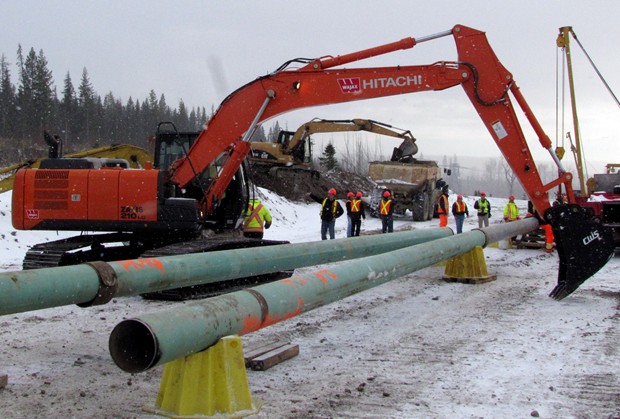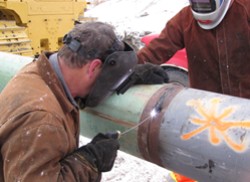Pipeline 101 Right Here in P.G.
Friday, December 7, 2012 @ 6:18 PM

New Pipeline construction program offers training on a site that is meant to replicate a regular pipeline installation – photos 250NEWS
Prince George, B.C. – With proposals for natural gas and oil pipelines to cross north central B.C., a special program is underway to give workers a lesson in “Pipeline 101”.
O’Brien Training in Prince George has spent the better part of a year developing a program that would give workers an opportunity to learn the basic skills necessary to land work on the construction of a pipeline.
With a site where simulated pipeline installation can be practiced, the first group of students is now half way through the program. “We have the only course its kind in Canada” says Dan O’Brien, “all aspects, real life scenarios, that’s what we have going right now.”
The first group of 15 students comes from first Nations from Ft. St. John through to Prince Rupert . The first group is funded by the Pacific Trails Pipeline Aboriginal Skills and Employment Program (PTP ASEP) which is focused on the skills needed to have First Nations take advantage of the employment opportunities of the PTP .
The pipeline’s design calls for it to cross through the traditional territories of 15 First Nations’ communities and stretch for almost 500km. This pipeline will deliver natural gas to a state of the art Liquid Natural Gas plant near Kitimat where it will be liquefied and then shipped to Asia. It is expected it will take two years to build the pipeline, and during that time, create as many as 2,000 jobs. The Kitimat LNG plant is projected to create 1500 jobs during its 3 year construction phase, and up to 100 permanent jobs once it has been completed.
Chad Chapple of Surerus Pipeline in Ft. St John, is a 20 year veteran of pipelining, and is working as a consultant with O’Brien Training in developing the program. He says the first class offers a wide range of ages “The youngest one is about 20 and the oldest is around 50, but these guys are great, they’re keen”.
Students spend a couple of hours each morning going through safety instruction and getting details on what the plan is for the day, and how it will be done. That plan could see students using heavy equipment to dig trenches, placing pipe in line, welding lengths of pipe together, “If it happens on the job, we will be doing it here” says Chapple.

( at right, the expert shows a student how to weld)
He says the program is not only giving some the knowledge they need to land a job now, for others, it’s an experience that could encourage them to take further instruction and achieve special certification. “There are some young guys here, who, this morning, never held a welding rod in their life, and now they’re welding, they’re not ticketed, but I bet they will be in a couple of years.”
Chapple says with all the pipeline projects that are in the wings, Prince George stands to become a central hub for pipeline activity “If it goes, when it goes, some of the gas lines are already happening and it’s right in the back yard of these guys. There is no trade of ‘pipelining’ it is a big labour force and they are always in need of labour. So after this, I hope the guys have the confidence and knowledge to just go to work.”

Comments
I have no problem with LNG (Liquid Natural Gas) crossing BC but absolutely no raw unrefined oil thank you. This is for obvious reasons as stated before (Dillbitt is impossable to clean up in the event of a spill or leak. A pipe leak is almost guarenteed to occurr. For this reason alone I would say no to a northern pipeline, but there are other ramifications on our west coast which make it prohibitive.
I also congratulate the government on training up the Canadian workforce and I wish those that take the training all of the success with their work.
I am wondering why that guy is hand welding. I would think that automatic orbital welding would be standard these days.
This video sure looks more realistic … done with some humour and some language.
http://www.youtube.com/watch?v=p_-2Apzy5mc&feature=endscreen&NR=1
;-)
So we are opening the doors for 3000 skilled foreign workers. We have a trades centre at CNC, yet our electricians, pipe fitters, instrument mechanics and others must go to south for schooling.
Are we creating more skills training options to fill this hole, or are we just acknowledging the shortage? This problem didn’t just pop up. I remember my teacher talking about this 30 years ago.
How many more journeyman are we producing, through BC schools, than we were 10 years ago?
Comments for this article are closed.